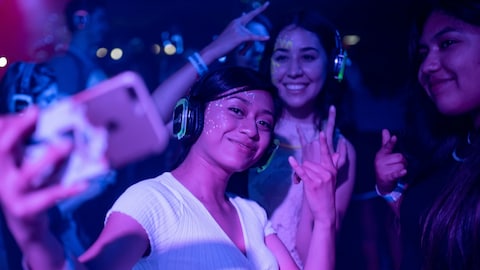Is 'bhajan clubbing' the coolest new way to party in India?
From flashing lights to devotional chants, young Indians are swapping techno drops for temple beats—and creating a whole new kind of nightlife.

Picture this: It’s Friday night. The lights are dim, incense is in the air, and the bass is thumping—not with EDM, but with the rhythmic beats of a dhol or a tabla. Instead of chanting lyrics about heartbreak or hustle, people are swaying, hands in the air, belting out “Hare Krishna” to a groovy remix. Welcome to bhajan clubbing—India’s newest subculture that’s part party, part prayer, and entirely Gen Z-approved.
This unexpected fusion of devotion and dance floor energy is redefining what post-work leisure means to young Indians. Gone are the days when bhajans were associated only with temples, grandparents, or early morning loudspeakers. Today, they are being played in dimly lit lounges, sunset rooftops, and even lavish halls, with DJs spinning Sanskrit mantras into bass-heavy bangers.
The new-age spiritual party scene
Bhajan clubbing is exactly what it sounds like: taking devotional songs (bhajans) and mixing them into high-energy, club-ready tracks. Think less religious ritual, more mindful raving. The vibe? Euphoric, collective, and oddly grounding.
The trend has been on the rise of late, and social media was seen flooded with clips of young people dancing barefoot, wearing bindis and sequined kurtas, swaying to 'Govinda' and 'Hare Krishna' remixes under disco lights, especially around the time of Navratri.
Why it’s hitting the right note with Gen Z
For Gen Z, bhajan clubbing is all about energy, emotion, and connection. This is the generation that meditates with YouTube, listens to lo-fi Hanuman Chalisa during study sessions, and wears evil-eye bracelets as fashion. So, when spirituality meets rhythm, it just clicks.
Many say it’s a rebellion against the “copy-paste” Western club scene that’s dominated India for years. After all, how many times can you dance to David Guetta remixes or the same techno loops before they start to feel...empty? Bhajan clubbing offers something fresher, more rooted. It is spiritual without being preachy, cool without being cringe.
There is also something deeper at play here: a yearning for meaning in chaos. After years of doom-scrolling, fast fashion, and hustle culture, young Indians are craving connection—to themselves, to their culture, and to each other. Bhajan clubbing, in a strange but beautiful way, fills that void.
Founder of Team Innovation Cultural, Mohit Bijlani, who produced and promoted Krishna Das' tours across India, stated, "This trend signals a significant cultural shift, reflecting a desire among younger audiences for experiences that are not merely entertainment but are deeply rooted in tradition. This generation is drawn to spirituality that feels personal, relatable and expressive, diverging from the archetypes of previous eras. These events provide not just euphoria but also tranquillity, cultivating a sense of community that counters the isolating effects of digital life. This shift indicates that spirituality is gaining renewed relevance among youth globally, establishing an alternative to conventional nightlife while reaffirming the importance of cultural and spiritual heritage in today’s context."
Instagrammable, yes—but also introspective
Let’s be real: part of the appeal is aesthetic. The soft lighting, the spiritual motifs, the incense smoke curling under mirror balls: it’s peak Insta-core! But beyond the filters, there’s genuine intention.
Many organisers frame these nights as safe spaces—alcohol-free, drug-free, and focused on collective joy. Instead of shots, you’ll find buttermilk and chai. Instead of hangovers, there is the post-event bliss of singing your heart out with strangers who feel like friends.
The future of India’s club culture?
It’s not hard to see why the 'bhajan clubbing' culture is booming in India. It bridges tradition and modernity, faith and fun, the sacred and the social. For India’s youth, who have grown up at the crossroads of cultural pride and global influence, bhajan clubbing is a way to be both rooted and radical. And if that means swapping shots for shlokas and smoke machines for sandalwood, well, count Gen Z in.
Bhajan clubbing isn’t about preaching or posturing; it is about feeling something real. It is about finding that same ecstatic release you’d get at a rave, but wrapped in the comfort of homegrown sound. In a world that’s constantly noisy, there’s something revolutionary about closing your eyes, raising your hands, and chanting 'Hare Krishna' to a deep bass drop, and that is what Gen Z is attracted to.
Lead image: Getty images
Also read: The digital nomad life and why everyone’s packing their laptops
Also read: What is ‘67’ and how it did it go from internet slang to word of the year?